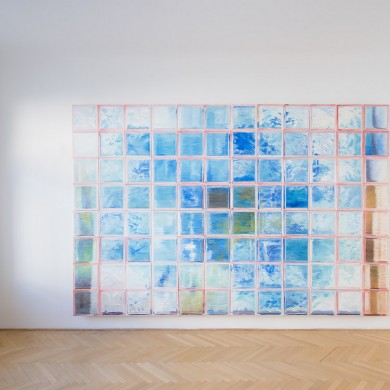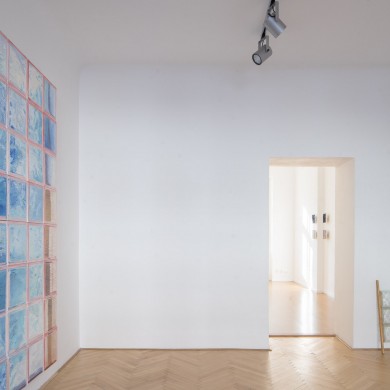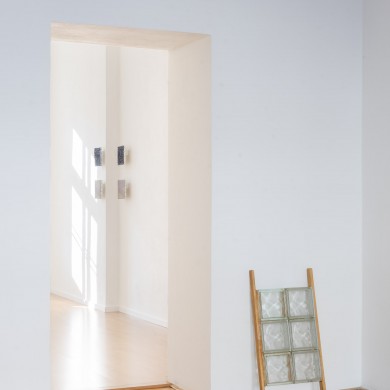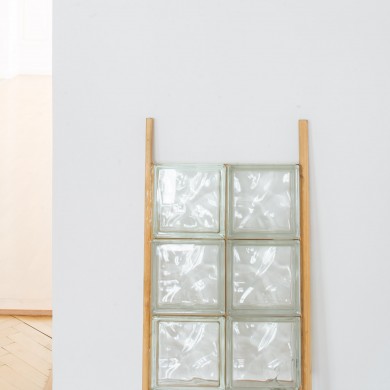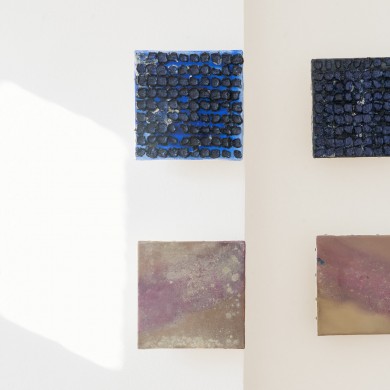Juraj Kollár | 0105
curated by Zuzana Janečková
9 Feb – 20 March 2018
ZAHORIAN & VAN ESPEN Praha
Juraj Kollár (1981) is an inconspicuously conspicuous artist and a pure painter. Classical photo-documentation of his art is practically impossible, or it is so superficial that it loses all power to transmit the experience which is offered when we look at his works directly, close-up. Besides, he manages without conceptual connotations, and it is evident that painting here is not hiding behind something else: quite the contrary, it strikes the viewer in its natural form, whether that be abstract, landscape, cityscape, portrait or figural motifs. The thoroughness with which the artist approaches observation and subsequent painting is expressed also in how he perceives the overall space and the lighting conditions. When I came to his studio it was in dusk. He had not turned on the light. Kollár works only in natural light, which in our geographical zone is much-reduced in wintertime. This adaptation to the natural conditions – even when in the urban setting of the studio, not the open air – is evident also in his understanding of the image as a permeable structure. He looks on the image as a structure through which it is possible to see out, and this structure is again more or less permeable. The illumination of images with artificial light creates a further filter of perception, which we can switch off when we wish.
The net or grille structure which often appears in Koller’s oil paintings evokes a kind of renaissance approach to perspective. Seeing as the artist does, we may perceive this perspective not only as a technical aid but, on another level, also as a shift in the significance of the content produced. The net becomes on the one hand a medium, on the other hand a supporting construction, of meanings: it points to the visual grid or pixelation of information through which we view the everyday reality around us. This is so distorted by subjective perception and optical illusions that often we are scarcely able to keep the essentials of it in view, without manipulation, for longer than a moment. Any halting or freezing of the moment of truth is thus unforgettable.
An important aspect of Kollár’s work, besides the light and the grid, is the scale of the image and the pastosity of the painting. Both elements play their part in terms of the overlap with other media: thanks to pastosity, the paintings come close to being a sculptural object and create reliefs which in places are reminiscent of ceramic mosaic murals. This is a parallel that cannot be disregarded. The scale of the picture is deliberately over-dimensioned in relation to the artist himself and the viewers. Sometimes the “magnification” is composed of smaller square formats and works up to an architectural solution of space even more dominant than the example in the current exhibition, whose title is taken from the number of the abstract painting 0105. It was the latter picture which motivated the production of the “doubled” painting we see here, 01052017. The first 0105 painting was produced in Prague in 2008, the second in Bratislava in 2017. Observing 0105 at an interval of time, the artist chose its current depiction through the analogical after-effect of the glass-and-concrete blocks, which evoke the architecture of the 1970s. We thus see something from the past through the filter of something else that evokes the past, and in a double mode: on the one hand Kollár is not using contemporary digital effects to change the perspective, while on the other hand he is gathering historical material connected with the past. The cleavage and haziness to view of this single picture is intensified through the influence of various filters, of which there are a number here: the original painting, time, glass-and-concrete, interpretation, light. The dominant position of the “original” painting, as a point of departure, is altogether fundamental, and even if it is physically absent from the exhibition as such, it figures in the exhibition’s title. Indeed, its absence shapes the significances of the new picture. We may think of the new painting as an analogous reproduction, which nonetheless creates a new original. This pair of paintings has its anchorage in certain places at certain times. Simultaneously, this pair is one picture with a time- and site-specific reflection on the artist’s own work: 2008– 2018 / Prague – Bratislava. Furthermore, thanks to the glass-and-concrete object and the built-in glass-and-concrete blocks at the gallery entrance, there is also a manifest overlap to a site-specific installation, which is inconspicuous but not coincidental. / Zuzana Janečková
Annual visual art programme of ZAHORIAN & VAN ESPEN Prague is implemented with financial support of city district of Prague 7
![]()
Juraj Kollár (1981) je nenápadně nápadný umělec a ryzí malíř. Klasická fotodokumentace jeho díla není prakticky možná, respektive je tak zploštěná, že postrádá veškerou přenositelnost zážitku, který se naskytne při pohledu na jeho díla z bezprostřední blízkosti. Obejde se i bez konceptuálních konotací a je vidět, že malba se tu neskrývá za něco dalšího, ale právě naopak zasahuje diváka ve své přirozené formě, ať už se jedná o abstrakci, krajinu, město, portrét nebo figurální motivy. Důslednost, s jakou autor přistupuje k pozorování a následnému malování, se projevuje i v tom, jak vnímá celý prostor a světelné podmínky. Když jsem přišla do jeho ateliéru, bylo šero. Nerozsvítil. Pracuje pouze během přirozeného světla, které je v zimním období v našem zeměpisném pásmu kratší. Toto přizpůsobení se přírodním podmínkám, i když v městském prostředí ateliéru a ne v plenéru, je evidentní i v jeho chápaní obrazu jako propustné struktury. Na obraz nazírá jako na strukturu, přes kterou je možné vidět ven, a tato struktura je pak více či méně propustná. Nasvícení obrazů umělým světlem zářivek pak tvoří další filtr vnímání, který na požádání můžeme vypnout.
Struktura, síť nebo mřížka, které se často v olejomalbách Juraje Kollára objevují, evokují také renesanční přístup k perspektivě. Z pohledu autora můžeme tuto perspektivu vnímat nejen jako technickou pomůcku, ale i v rovině posunu významu obsahového sdělení. Síť se stává jednak prostředkem, jednak nosnou konstrukcí významů, upozorňuje na vizuální rastr nebo pixelaci informací, přes které vnímáme každodenní realitu kolem sebe. Ta je tak pokroucená subjektivním vnímáním a optickými klamy, že často jen stěží můžeme bez manipulace zahlédnout její podstatu na delší moment. Zastavení nebo zmražení okamžiku pravdy je pak nezapomenutelné.
Důležitým aspektem v tvorbě Juraje Kollára je kromě světla a rastru také velikost obrazu a pastóznost malby. Oba prvky hrají svou roli v rámci přesahu do jiných médií – díky pastóznosti se obrazy blíží k objektu a vytváří reliéfy připomínající místy až nástěnné keramické mozaiky. Není možné tuto paralelu přehlédnout. Mírka obrazů je záměrně ve vztahu k samotnému autorovi a divákům naddimenzovaná. Někdy se „zvětšenina“ skládá z menších čtvercových formátů a vstupuje do architektonického řešení prostoru ještě dominantněji, tak, jako se to děje i v stávající výstavě, jejíž název je odvozen od názvu abstraktního obrazu 0105. Právě tento obraz se stal motivací pro vznik „dvojdomé“ malby 01052017, kterou zde vidíme. První malba 0105 vznikla v Praze v roce 2008, nová v Bratislavě v roce 2017. Autor pozoruje malbu 0105 s odstupem času a zvolil její aktuální zobrazení přes analogový after effect sklobetonových tvárnic evokujících architekturu 70. let. Vidíme tedy něco z minulosti přes filtr něčeho, co navíc minulost i evokuje, a to dvojím způsobem – jednak nepoužívá na změnu optiky současné digitální efekty, jednak si vybírá materiál historicky spjatý z minulostí. Rozdvojenost a zamlženost pohledu na jeden obraz se stupňuje také v rámci různých filtrů, kterých je tu hned několik – původní malba, čas, sklobeton, interpretace, světlo. Dominantní pozice „původní“ malby jako výchozího bodu je zcela zásadní, i když fyzicky na výstavě absentuje, figuruje v názvu výstavy. Právě její nepřítomnost formuje významy obrazu nového. O nové malbě můžeme uvažovat jako o analogové reprodukci, která však vytváří nový originál. Tato dvojice obrazů je ukotvena jistými místy v jistých časech. Zároveň je tato dvojice jedním obrazem s time a site specific sebereflexí na vlastní dílo – 2008 – 2018 / Praha – Bratislava. Ve výstavě se navíc objevuje díky sklobetonovému objektu a zabudovaným sklobetonovým tvárnicím při vstupu do galerie také přesah do site-specific instalace, který je sice nenápadný, ale není náhodný. / Zuzana Janečková
Celoroční výstavní program vizuálního umění v ZAHORIAN & VAN ESPEN je realizován za finanční podpory městské části Praha 7
![]()
